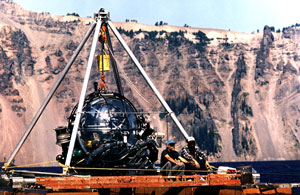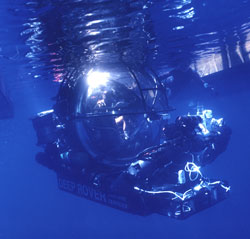Studies of Hydrothermal Processes in Crater Lake, Oregon – extracted from OSU College of Oceanography Report #90-7
Field Methods
The results summarized below, cover field programs and laboratory analyses which have been carried out between 1987 and 1991. During the summer of 1987, our research group spent 20 days at Crater Lake, during which time we performed extensive sampling operations and made thermal and chemical measurements from the surface research vessel. We introduced the use of a remotely operated vehicle (ROV) for making detailed observations of the bottom of Crater Lake. Seven ROV deployments were made which provided information on the sediment thickness, the presence of benthic plants and animals, and the existence of unusual precipitates and crusts which were in marked contrast to the normal buff-colored sediments that blanket much of the bottom.
The hydrothermal field program for 1988 was based on three separate expeditions to the lake during the summer when the lake is accessible. These included extensive sampling programs from surface boats and a 25 day dive program using the submersible Deep-Rover (http://www.nuytco.com/deeprover.html). The one-person submersible was used to locate, observe, and sample geological, geochemical, and biological features in the deep lake that had been hitherto inaccessible. The 1989 field programs continued the surface and submersible studies between June-September. In all, we made over 47 dives to the lake bottom with Deep Rover and 7 ROV dives.
Other pages in this section
*** previous title *** --- *** next title ***



